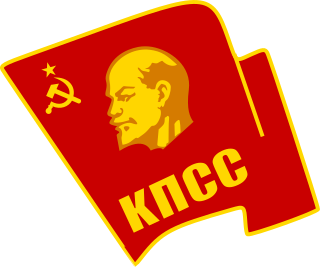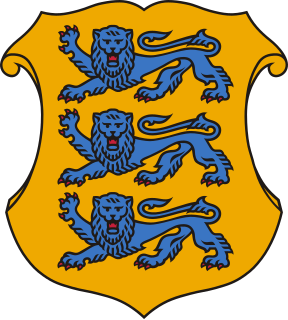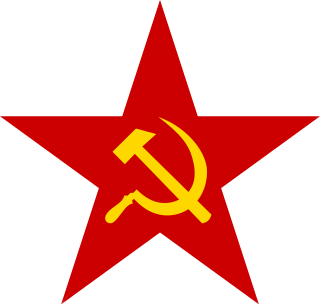The history of Estonia forms a part of the history of Europe. Humans settled in the region of Estonia near the end of the last glacial era, beginning from around 8500 BC. Before German crusaders invaded in the early 13th century, proto-Estonians of ancient Estonia worshipped spirits of nature. Starting with the Northern Crusades in the Middle Ages, Estonia became a battleground for centuries where Denmark, Germany, Russia, Sweden and Poland fought their many wars over controlling the important geographical position of the country as a gateway between East and West.

The Latvian Soviet Socialist Republic, also known as Soviet Latvia or Latvia, was a republic of the Soviet Union.

The occupation of the Baltic states involved the military occupation of the three Baltic states—Estonia, Latvia and Lithuania—by the Soviet Union under the auspices of the 1939 Molotov–Ribbentrop Pact in June 1940. They were then incorporated into the Soviet Union as constituent republics in August 1940, though most Western powers never recognised their incorporation. On 22 June 1941, Nazi Germany attacked the Soviet Union and within weeks occupied the Baltic territories. In July 1941, the Third Reich incorporated the Baltic territory into its Reichskommissariat Ostland. As a result of the Red Army's Baltic Offensive of 1944, the Soviet Union recaptured most of the Baltic states and trapped the remaining German forces in the Courland pocket until their formal surrender in May 1945. The Soviet "annexation occupation" or occupation sui generis of the Baltic states lasted until August 1991, when the three countries regained their independence.
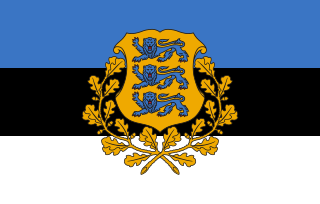
The President of the Republic of Estonia is the head of state of the Republic of Estonia. The current President is Kersti Kaljulaid, elected by Parliament on 3 October 2016, becoming the first woman and youngest person ever who holds the position.

The Forest Brothers were Estonian, Latvian, and Lithuanian partisans who waged a guerrilla war against Soviet rule during the Soviet invasion and occupation of the three Baltic states during, and after, World War II. Similar anti-Soviet Eastern European resistance groups fought against Soviet and communist rule in Bulgaria, Poland, Romania, and western Ukraine.

The Baltic Way or Baltic Chain was a peaceful political demonstration that occurred on 23 August 1989. Approximately two million people joined their hands to form a human chain spanning 675.5 kilometres (419.7 mi) across the three Baltic states – Estonia, Latvia, and Lithuania, which were considered at the time to be constituent republics of the Soviet Union.
The People's Seimas was a puppet legislature organized in order to give legal sanction the occupation and annexation of Lithuania by the Soviet Union. After the Soviet ultimatum in June 1940, a new pro-Soviet government was formed, known as the People's Government. The new government dismissed the Fourth Seimas and announced elections to the People's Seimas. The elections were heavily rigged, and resulted in a chamber composed entirely of Communists and Communist sympathizers. The new parliament unanimously adopted a resolution proclaiming the Lithuanian Soviet Socialist Republic and petitioned for admission to the Soviet Union as a constituent republic. The Supreme Soviet of the USSR accepted the Lithuanian petition on August 3, 1940. The People's Seimas adopted a new constitution, a close copy of the 1936 Soviet Constitution, on August 25 and renamed itself to the Supreme Soviet of the Lithuanian SSR.

The Act of the Re-Establishment of the State of Lithuania or Act of March 11 was an independence declaration by the Lithuanian Soviet Socialist Republic adopted on March 11, 1990, signed by all members of the Supreme Council of the Republic of Lithuania led by Sąjūdis. The act emphasized restoration and legal continuity of the interwar-period Lithuania, which was occupied by the USSR and lost independence in June 1940. It was the first time that an occupied state declared independence from the dissolving Soviet Union.
Soviet deportations from Estonia were a series of mass deportations by the Soviet Union from Estonia in 1941 and 1945–1951.
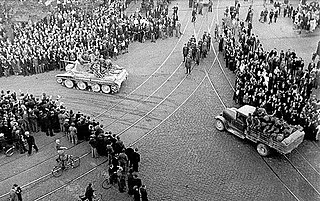
The Soviet occupation of Latvia in 1940 refers, according to the European Court of Human Rights, the Government of Latvia, the United States Department of State, and the European Union, to the military occupation of the Republic of Latvia by the Soviet Union ostensibly under the provisions of the 1939 Molotov–Ribbentrop Pact with Nazi Germany.
Operation Priboi was the code name for the Soviet mass deportation from the Baltic states on 25–28 March 1949. The action is also known as the March deportation by Baltic historians. More than 90,000 Estonians, Latvians and Lithuanians, labeled as enemies of the people, were deported to forced settlements in inhospitable areas of the Soviet Union. Over 70% of the deportees were women, and children under the age of 16.

The Soviet Union issued an ultimatum to Lithuania before midnight of June 14, 1940. The Soviets, using a formal pretext, demanded to allow an unspecified number of Soviet soldiers to enter the Lithuanian territory and to form a new pro-Soviet government. The ultimatum and subsequent incorporation of Lithuania into the Soviet Union stemmed from the division of Eastern Europe into the German and Russian spheres of influence in the Molotov–Ribbentrop Pact of August 1939. Lithuania, along with Latvia and Estonia, fell into the Russian sphere. According to the Soviet–Lithuanian Mutual Assistance Treaty of October 1939, Lithuania agreed to allow some 20,000 of Soviets troops to be stationed at several bases within Lithuania in exchange for a portion of the Vilnius Region. Further Soviet actions to establish its dominance in its sphere of influence were delayed by the Winter War with Finland and resumed in spring 1940 when Germany was making rapid advances in western Europe. Despite the threat to the independence, Lithuanian authorities did little to plan for contingencies and were unprepared for the ultimatum.
The term People's Parliaments or People's Assemblies was used in 1940 for puppet legislatures put together after show elections in Estonia, Latvia, and Lithuania to legitimize the occupation by the Soviet Union. In all three countries, the elections to the parliaments followed the same scenario, dictated by functionaries in Moscow and borrowed from incorporation of Belarusian and Ukrainian lands in the aftermath of the invasion of Poland in 1939.
The Sovietization of the Baltic states refers to the sovietization of all spheres of life in Estonia, Latvia and Lithuania when they were under control of the Soviet Union. The first period deals with the occupation from June 1940 to July 1941 when the German occupation began. The second period covers 1944 when the Soviet forces pushed the German out, until 1991 when independence was declared.

The Estonian Soviet Socialist Republic, also known as Soviet Estonia or Estonia was an unrecognized republic of the Soviet Union, administered by a subordinate of the Soviet government. The ESSR was initially established on the territory of the Republic of Estonia on 21 July 1940, following the invasion of Soviet troops on 17 June 1940, and the installation of a puppet government backed by the Soviet Union, which declared Estonia a Soviet constituency. The Estonian SSR was subsequently incorporated into the Soviet state on 9 August 1940. The territory was occupied by Nazi Germany from 1941 to 1944 and administered as a part of Reichskommissariat Ostland.

The background of the occupation of the Baltic states covers the period before the first Soviet occupation on 14 June 1940, stretching from independence in 1918 to the Soviet ultimatums in 1939–1940. The Baltic states gained their independence during and after the Russian revolutions of 1917; Lenin's government allowed them to secede. They managed to sign non-aggression treaties in the 1920s and 1930s. Despite the treaties, the Baltic states were forcibly incorporated into the Soviet Union in 1940 in the aftermath of the German–Soviet pact of 1939.

The Soviet occupation of the Baltic states covers the period from the Soviet–Baltic mutual assistance pacts in 1939, to their invasion and annexation in 1940, to the mass deportations of 1941.

Parliamentary elections were held in Lithuania in 1940. They followed an ultimatum from the Soviet Union to allow Soviet troops to enter the country and operate freely. President Antanas Smetona left Lithuania on 15 June as the Soviet Army occupied the country and took control of the government. After a puppet government led by Justas Paleckis was installed, rigged elections were held.

Parliamentary elections were held in Latvia on 14 and 15 July 1940, alongside simultaneous similarly undemocratic and anticonstitutional elections in Estonia and Lithuania, following the Soviet occupation of the three countries. The Communist Party of Latvia was legalised and renamed the "Working People's Bloc" (Darba ļaužu bloks). It was the sole permitted participant in the election, as an attempt to include the Democratic Bloc on the ballot was suppressed, and the main figures of the bloc either arrested and deported or shot shortly after, while a few managed to escape the repression by fleeing from the country.


